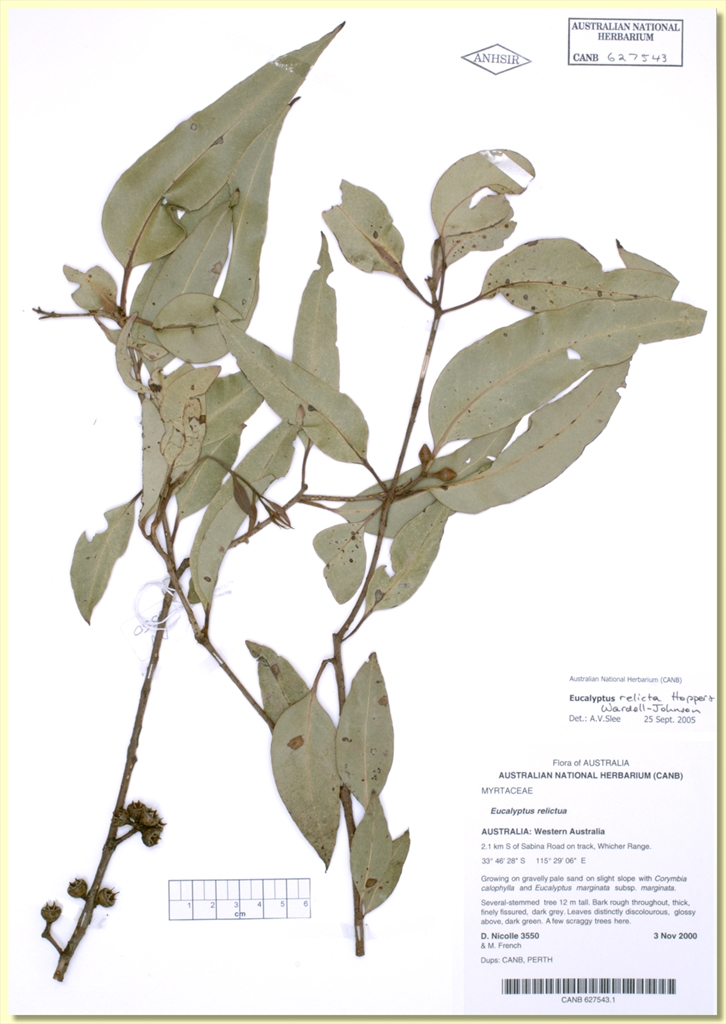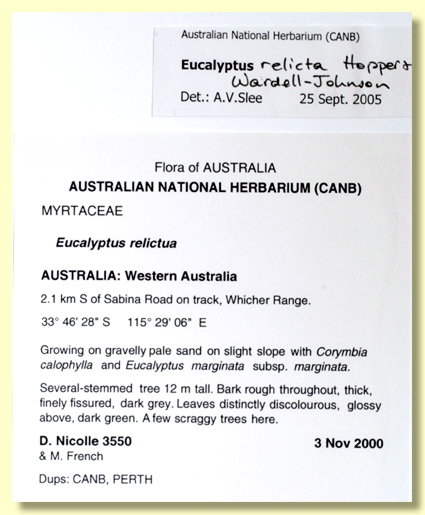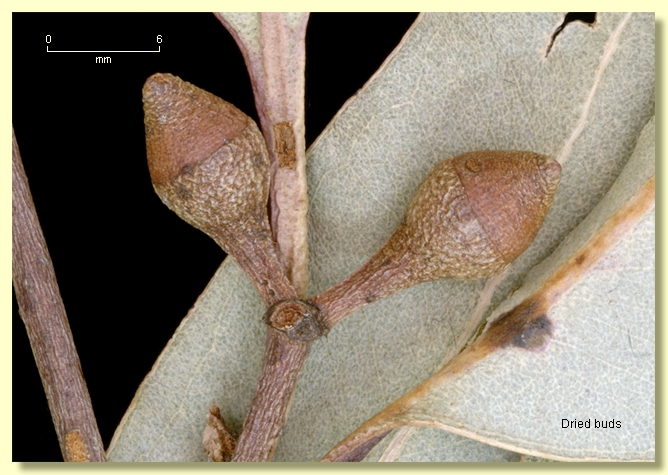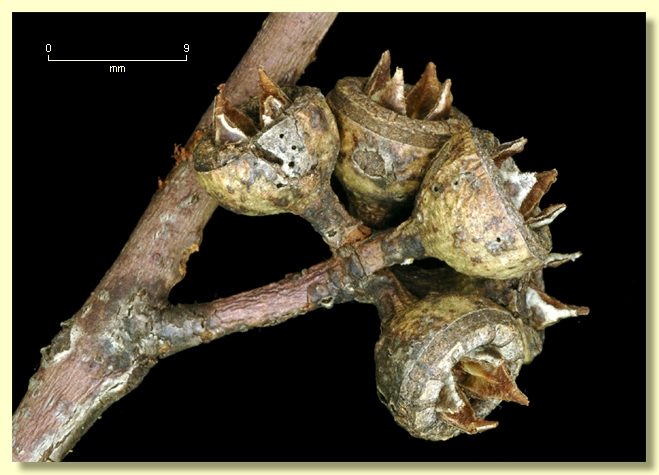Eucalyptus | Symphyomyrtus | Bisectae | Destitutae | Curviptera | Inflexae
Euclid - Online edition
Eucalyptus relicta
Eucalyptus relicta Hopper & Wardell-Johnson, Nuytsia 15: 235 (2004).
T: Western Australia: 3.0 km E of Sabina Road, 33° 46' 11" S, 115° 27' 53" E, 21 Jan. 1993, G.Wardell-Johnson 3180; holo: PERTH.
Tree to 12 m tall, sometimes branching near ground level. Forming a lignotuber.
Bark rough to small branchlets, thick, deeply fissured, dark grey.
Branchlets lacking oil glands in the pith.
Juvenile growth (coppice or field seedlings to 50 cm): not seen by us; Hopper & Wardell-Johnson (ibid.) state "coppice leaves ovate, acute".
Adult leaves alternate, petioles 1.2–2.5 cm long; blade lanceolate to falcate, 8.8–18 cm long, 1.5–3 cm wide, base tapering to petiole, margin entire, apex finely pointed, discolorous, glossy, darker green above, side-veins at about 45° to midrib, reticulation dense uncertain, intramarginal vein close to margin.
Inflorescence axillary unbranched, peduncles ± terete, 0.9–1.8 cm long, buds ?7 up to 11 and 13 per umbel, pedicels 0.3–0.5 cm long. Mature buds ovoid, 0.6–1 cm long, 0.4–0.7 cm wide, scar present (outer operculum shed early), operculum conical, stamens inflexed, anthers ± oblong, versatile, sub-basifixed, dehiscing by longitudinal slits, style long and straight, stigma tapered to blunt, locules 4, the placentae each with 4 vertical rows of ovules. Flower colour unknown.
Fruit pedicellate (pedicels 0.2–0.5 cm long), hemispherical to broadly obconical or cupular, 0.4–0.6 cm long, 0.7–0.8 cm wide, disc raised and ± oblique or level, valves 4, strongly exserted.
Seeds grey-brown to brown, 1–2 mm long, flattened-ovoid, dorsal surface shallowly reticulate, hilum ventral.
Cultivated seedling (measured at node 10): not grown.
Flowering has been recorded in January and February (Hopper & Wardell-Johnson, 2004).
Small tree restricted to Western Australia where found only in the area just south-east of Busselton in the Whicher Range, on the upper slopes of valleys on sandy loam to clay loam soils. Eucalyptus relicta is fully rough-barked, has glossy green adult leaves paler on the underside and fruit with exserted valves.
E. relicta grows with three other eucalypts with rough bark and discolorous adult leaves, the bloodwoods Corymbia haematoxylon and C. calophylla, both of which have terminal inflorescences and much larger fruit with enclosed valves, and the jarrah, E. marginata, which has elongated buds and larger barrel-shaped to more or less globose fruit with valves at rim level. A fourth rough-barked species, Eucalyptus decipiens subsp. chalara, also occurs in the vicinity, and in form and bark is much more like E. relicta, but differs in having concolorous adult leaves, sessile, more slender buds, and fruit with valves at rim level or slightly exserted.
E. relicta is most closely related to the more widespread coastal mallee or small tree, E. lane-poolei, which has smooth to scaly bark and larger buds and fruit and concolorous adult leaves; and also to the newly described E. virginea, a taller smooth-barked forest tree with adult leaves paler on the underside, restricted to the Denmark area. These three species together form Eucalyptus series Curviptera subseries Inflexae.
Eucalyptus relicta : Latin relicta, something left behind, referring to the species being a relict of wetter times. The discolorous adult leaves of this species suggest its evolutionary origin was in much wetter forest than the dry sclerophyll forest where the species now resides.










